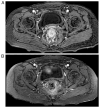Skin metastasis from ovarian cancer with somatic BRCA1 mutation: A case report and literature review
- PMID: 38872856
- PMCID: PMC11170256
- DOI: 10.3892/ol.2024.14481
Skin metastasis from ovarian cancer with somatic BRCA1 mutation: A case report and literature review
Abstract
Skin metastasis from ovarian cancer is rare, and its prognosis is poor. Effective therapeutic strategies are currently lacking, but the combination of various treatment methods shrink the tumor and relieve symptoms. The present study reports a rare case of advanced ovarian cancer with skin metastases and intestinal wall thickening, along with a BRCA1 DNA repair associated (BRCA1) mutation. After standard first-line treatment and non-standard second-line treatment, the patient developed skin metastases. The patient's skin itching, pain and lesions were completely relieved after administering bevacizumab in combination with paclitaxel and carboplatin. After 4 months, skin metastases recurred along with anal distension during maintenance treatment with oral poly(ADP ribose) polymerase (PARP) inhibitors. The patient was treated again with bevacizumab combined with docetaxel, and the anal distension was significantly relieved. Angiogenesis therapy combined with chemotherapy is effective, but that the disease-free survival time is short, and PARP inhibitor maintenance effect is limited even in cases with a BRCA1 gene mutation.
Keywords: BRCA1 DNA repair associated; angiogenesis; bevacizumab; intestinal wall thickening; ovarian neoplasms; poly(ADP ribose) polymerase inhibitors.
Copyright: © 2024 Zhang et al.
Conflict of interest statement
The authors declare that there are no competing interests.
Figures






Similar articles
-
An update on current and emerging therapies for epithelial ovarian cancer: Focus on poly(adenosine diphosphate-ribose) polymerase inhibition and antiangiogenesis.J Oncol Pharm Pract. 2017 Sep;23(6):454-469. doi: 10.1177/1078155216657165. Epub 2016 Jun 29. J Oncol Pharm Pract. 2017. PMID: 27357817 Review.
-
Efficacy and Safety of Platinum-based Chemotherapy With Bevacizumab Followed by Bevacizumab Maintenance for Recurrent Ovarian, Fallopian Tube, and Primary Peritoneal Cancer During PARP Inhibitor Therapy: A Multicenter Retrospective Study.Anticancer Res. 2023 Mar;43(3):1265-1272. doi: 10.21873/anticanres.16273. Anticancer Res. 2023. PMID: 36854492
-
Current strategies for the targeted treatment of high-grade serous epithelial ovarian cancer and relevance of BRCA mutational status.J Ovarian Res. 2019 Jan 28;12(1):9. doi: 10.1186/s13048-019-0484-6. J Ovarian Res. 2019. PMID: 30691488 Free PMC article. Review.
-
Complete pathological response to olaparib and bevacizumab in advanced cervical cancer following chemoradiation in a BRCA1 mutation carrier: a case report.J Med Case Rep. 2021 Apr 23;15(1):210. doi: 10.1186/s13256-021-02767-9. J Med Case Rep. 2021. PMID: 33888155 Free PMC article.
-
Clinical Application of Poly(ADP-Ribose) Polymerase Inhibitors in High-Grade Serous Ovarian Cancer.Oncologist. 2016 May;21(5):586-93. doi: 10.1634/theoncologist.2015-0438. Epub 2016 Mar 28. Oncologist. 2016. PMID: 27022037 Free PMC article. Review.
References
-
- Pavlidis N, Rassy E, Vermorken JB, Assi T, Kattan J, Boussios S, Smith-Gagen J. The outcome of patients with serous papillary peritoneal cancer, fallopian tube cancer, and epithelial ovarian cancer by treatment eras: 27 Years data from the SEER registry. Cancer Epidemiol. 2021;75:102045. doi: 10.1016/j.canep.2021.102045. - DOI - PubMed
Publication types
LinkOut - more resources
Full Text Sources
Miscellaneous
